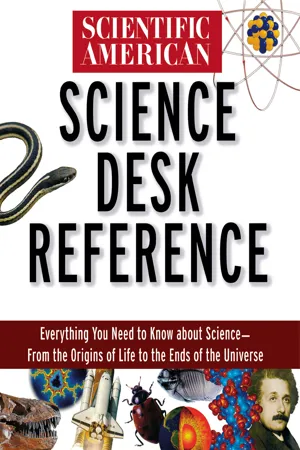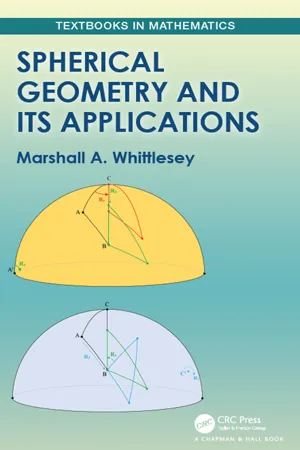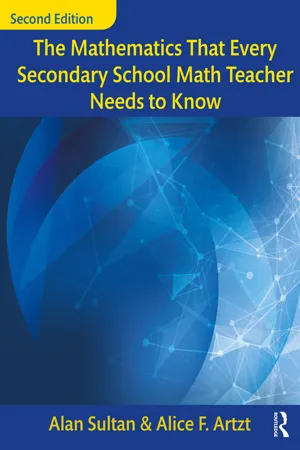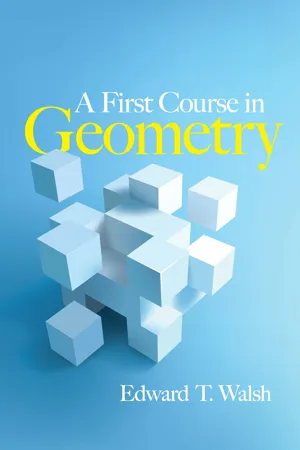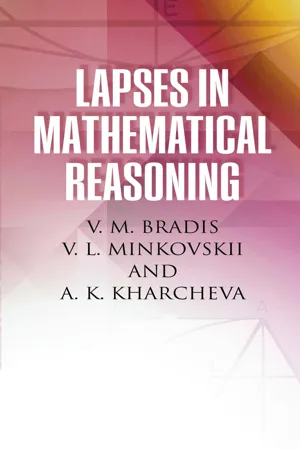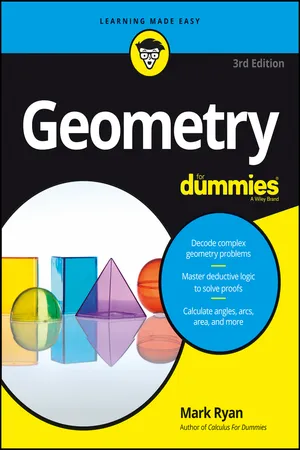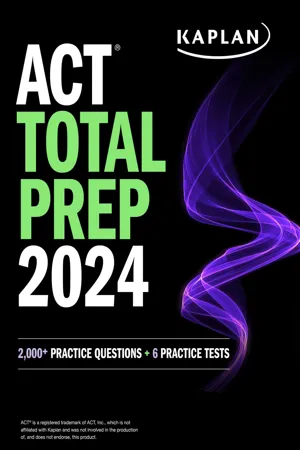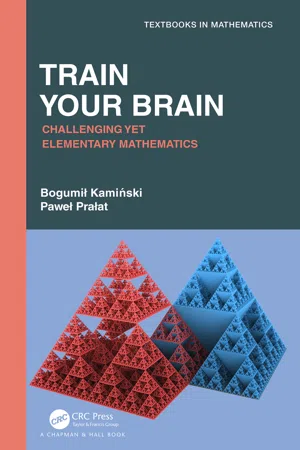Mathematics
Similar Triangles
Similar triangles are two or more triangles that have the same shape but may differ in size. Their corresponding angles are equal, and their corresponding sides are in proportion to each other. This property allows for the use of ratios to solve for unknown side lengths or angles in similar triangles.
Written by Perlego with AI-assistance
Related key terms
9 Key excerpts on "Similar Triangles"
- eBook - ePub
- (Author)
- 2008(Publication Date)
- Trade Paper Press(Publisher)
similar . All circles are similar. All squares are similar. Triangles are similar if corresponding angles are equal.angles in triangles The exterior angle of a triangle is equal to the sum of the opposite interior angles.triangle types of triangle.triangle A triangle is a three-sided plane figure, the sum of whose interior angles is 180°. Triangles can be classified by the relative lengths of their sides. A scalene triangle has three sides of unequal length; an isosceles triangle has at least two equal sides; an equilateral triangle has three equal sides (and three equal angles of 60°).median The median is the name given to a line from the vertex (corner) of a triangle to the midpoint of the opposite side.A right-angled triangle has one angle of 90°. If the length of one side of a triangle is l and the perpendicular distance from that side to the opposite corner is h (the height or altitude of the triangle), its area A = lh .hypotenuse The longest side of a right-angled triangle, opposite the right angle, is the hypotenuse. It is of particular application in the Pythagorean theorem (the square of the hypotenuse equals the sum of the squares of the other two sides), and in trigonometry where the ratios sine and cosine (see under trigonometry below) are defined as the ratios opposite/hypotenuse and adjacent/hypotenuse respectively.altitude The altitude of a figure is the perpendicular distance from a vertex (corner) to the base (the side opposite the vertex).circle Technical terms used in the geometry of the circle; the area of a circle can be seen to equal πr2 by dividing the circle into segments which form a rectangle.The Pythagorean theorem
The Pythagorean theorem states that in a right-angled triangle, the area of the square on the hypotenuse (the longest side) is equal to the sum of the areas of the squares drawn on the other two sides. If the hypotenuse is h units long and the lengths of the other sides are a and b , then h 2 = a 2 + b 2 - eBook - ePub
- Marshall Whittlesey(Author)
- 2019(Publication Date)
- Chapman and Hall/CRC(Publisher)
EF, then the triangles are similar. The SAS similarity theorem depends on the parallel postulate.The most important consequence of the similarity properties of planar triangles is:Theorem 1.3 (Pythagorean theorem) If a right triangle has sides of length a, b, and c, where c is the length of the hypotenuse, then a2 + b2 = c2 .With the Pythagorean theorem in the plane, the hypotenuse-leg congruence theorem for right triangles is not difficult to deduce. (See Exercise 9.) However, the Pythagorean theorem depends on the parallel postulate, and it turns out that the hypotenuse-leg theorem can be proven without the assumption of the parallel postulate. This is also discussed in the exercises.In any triangle, the sum of the measures of the angles is π radians (180°). An immediate consequence is that the measure of an exterior angle is equal to the sum of the measures of the opposite interior angles.Suppose that A1 , A2 , …, Anis a set of n points in a plane such that no three consecutive points on the list are collinear. Consider the segments, and,¯A 1A 2,¯A 2A 3, … ,¯A 3A 4¯An − 1A n. If no two of them intersect anywhere but at their endpoints, their union is a polygon of n sides. A quadrilateral is a polygon of four sides and a pentagon is a polygon of five sides. A parallelogram is a quadrilateral where the non-intersecting (opposite) sides are parallel. If the opposite sides in a parallelogram are congruent, the parallelogram is called a rhombus. A rectangle is a quadrilateral such that the angle between any two sides with a common endpoint is a right angle. A square is a rectangle whose sides all have the same length. A trapezoid is a quadrilateral where one pair of two opposite sides is parallel (the bases) and the other pair of opposite sides is not parallel. The distance between the parallel sides is the height of the trapezoid. A trapezoid is said to be isosceles if the non-parallel sides are congruent. Given a trapezoid, there exists a line parallel to both bases halfway between the bases. This line intersects the non-parallel sides in one point each. The line segment between these two points is called the midline or median¯A nA 1 - Alan Sultan, Alice F. Artzt(Authors)
- 2017(Publication Date)
- Routledge(Publisher)
DE ? Are you correct?- 3 What can you say about the shapes of triangles ABC and AED ? Why do you believe this is true?
After having done the launch question, you are probably beginning to recall some of the basic properties of Similar Triangles. Did you ever question how the similarity theorems you learned in secondary school could be proven? In this section we will surprise you with how they can be done.We have used the Law of Sines and the Law of Cosines to derive all the congruence theorems that are taught in geometry. But now let us turn to another set of results that are also critically important, those that deal with similarity. Applications of similarity range from the mundane to the surprising. For example, similarity is used on a daily basis by engineers who use scale drawings to create a model of a building that is going to be constructed. When you take a picture of a person, the picture you get is similar to the person. Similarity is also used (surprisingly) in radiation therapy for cancer patients for accuracy in focusing the beam. To find out more about this, visit the website: www.learner.org/courses/learningmath/geometry/session8/video.html and watch the video on “Similar Triangles and Radiation Therapy.”We will now show how the Law of Sines and the Law of Cosines can be used to develop ALL the main results about similarity. The versatility of these laws is quite remarkable. Recall that two triangles, ABC and DEF are called similar if they have the same shape, but not necessarily the same size. This means that one is a scaled version of the other. The formal definition of similarity between triangles ABC and DEF is that the angles of triangle ABC are congruent to those of triangle DEF, and that the sides opposite the corresponding congruent angles (that is, the corresponding sides) are proportional. When one writes that two triangles are similar, the order in which the letters are written reveals which angles are congruent. Thus, when we write that triangle ABC is similar to triangle DEF , it follows that ∡A = ∡D , ∡B = ∡E , and ∡C = ∡F . Saying that the sides of the triangles are proportional means that there is a number k such that a = kd, b = ke , and c = kf , where a, b, c and d, e, f are respectively, the corresponding sides of the triangles. See Figure 5.9- eBook - ePub
- Edward T Walsh(Author)
- 2014(Publication Date)
- Dover Publications(Publisher)
Geometry will draw the soul toward truth.PLATOCHAPTER SIX
SIMILARITY
6.1 INTRODUCTION
In the sixth century B.C ., the illustrious mathematician Pythagoras founded a school which adopted the philosophical premise that the examination of everything in nature, geometric forms included, would yield properties that could be expressed in terms of whole numbers. According to legend, the Pythagoreans were onboard ship when one of them demonstrated to the others that, no matter what unit of measure was employed, it was impossible to express the lengths of the legs and hypotenuse of an isosceles right triangle as whole numbers. Since this fact violated Pythagorean doctrine, it was viewed as a serious threat by the Pythagoreans, who responded by throwing its heretical author overboard–or so the story goes.Thus was generated a “crisis” in mathematics which lasted for nearly two hundred years, until Eudoxus invented his elegant and ingenious theory of ratio and proportion. Eudoxus’ work is generally believed to have furnished the entire content of Book V of Euclid’s Elements.In previous chapters, we examined the congruence relation between geometric sets of points. Specifically, we defined congruence for segments, angles, and triangles. When we say that two such figures are congruent, we are saying that they are the same shape and the same size.In this chapter we will begin to consider relations between figures that are the same shape but not necessarily the same size. We have a name for such figures: We say they are similar.Eudoxus’ theory of proportion provides the tools we will use to explore and refine the similarity relation. The notion of similarity will then lead us to a proof of what is known as the Pythagorean Theorem - eBook - ePub
Making Sense of Mathematics for Teaching High School
Understanding How to Use Functions
- Edward C. Nolan, Juli K. Dixon, Farhsid Safi, Erhan Selcuk Haciomeroglu(Authors)
- 2016(Publication Date)
- Solution Tree Press(Publisher)
Students build on their work with right triangles and the Pythagorean theorem from grade 8 as they explore trigonometric relationships. Trigonometry is the study of the relationships of angle measures and lengths of sides of triangles. This connects student understanding of similarity to relationships within right triangles. Students solve problems involving trigonometry both in and out of context.The MathematicsMaking sense of shape and space provides the tools to describe the world. Students in the middle grades are introduced to transformations, congruence, and similarity. High school students formalize these understandings, using them to explore transformations and demonstrate geometric relationships. Students will also use proof and constructions to investigate congruence and similarity.Exploring TransformationsOne important aspect of the study of geometry in high school entails establishing and extending understanding of transformations and how they relate to other mathematical topics. In considering rigid motion transformations, you are connecting the impact of reflections, rotations, and translations on sides and angles of figures as well as the consequences of performing each type of rigid motion transformation to the position and orientation of these figures. The following investigation connects similarity, non-rigid transformations, proportional reasoning, trigonometric relationships, and function representations (see figure 3.4 , page 62).How can transformations be used to map a pre-image to an image that is similar but not congruent? Perhaps you started with a translation of 5 units to the right followed by another translation—down by 1 unit—resulting in a triangle similar to ΔDEF with angle A″ concurrent with angle D from figure 3.4 (see figure 3.5 , page 62).Figure 3.4: Geometry transformation task.Figure 3.5: A series of two translations.A helpful discussion for students is to justify how they know that ΔA″B″C″ is congruent to ΔABC. They should deduce that since all of the vertices are moved in the same direction and by the same number of units, the new triangle must be the same, or congruent, because a triangle is determined by its vertices. However, ΔDEF is not congruent to ΔABC. What transformation will map ΔA″B″C″ to ΔDEF? Dilations map pre-images to images that are similar but not congruent. The scale factor determines the expansion or contraction of the pre-image about the center of dilation. If the center of dilation is located on the pre-image, then that position in space is conserved. For example, by performing a dilation on ΔA″B″C″ with the center of dilation at A″ and a scale factor of 2, the image, has a vertex that is concurrent with A″, and the ratio of the length of the sides of to the length of the sides of ΔA″B″C″ is 2:1 (see figure 3.6 ). The vertices of concur with the vertices of ΔDEF - eBook - ePub
- V. M. Bradis, L. Minkovskii, A. K. Kharcheva(Authors)
- 2016(Publication Date)
- Dover Publications(Publisher)
III. Stories, with Explanations, of Causes of Erroneous Reasoning63. Similar Triangles with equal sidesTake two similar scalene triangles and denote the sides of the first in the order of increasing size by the letters a, b, c (a < b < c), and the corresponding sides of the second by the letters a1 , b1 , c1 . By virtue of proportionality of the corresponding sides of similar polygons we have: a1 = aq, b1 = bq, c1 = cq, where q is the coefficient of proportionality, and therefore a1 < b1 < c1 .If q = 1, then all the sides of the two triangles are respectively equal, and the triangles are congruent. The congruence of the triangles is thus a special case of similarity.It may seem, that if the triangles are similar, but not congruent, then they have no equal sides. The erroneousness of such a conclusion is shown by a simple consideration of triangles with the sides 8, 12, 18 cm, and 12, 18, 27 cm. The sides of the second are one-and-one-half times as large as the corresponding sides of the first, and therefore the triangles are similar (but not congruent). As we see, these two triangles have two pairs of respectively equal sides.We shall establish the conditions which have to be satisfied by two similar, but not congruent, triangles having two pairs of respectively equal sides.Suppose that q > 1. The smallest side a of the first triangle (with the sides a, b, c) is less than the smallest side a1 of the second triangle (with sides a1 = aq, b1 = bq, c1 = cq), and cannot be equal to any of the sides of the latter.The middle side b of the first triangle may be equal only to the smallest side a1 of the second triangle (since b is less than b1 = bq and much smaller than c1 = cq), and the greatest side c of the first triangle is equal either to the smallest side a1 or to the middle side b1 of the second triangle. If two sides of the first triangle are equal to two sides of the second triangle, then b = a1 , c = b1 . Hence b = aq, c = bq = aq × q = aq2 . Thus the sides of the first triangle form a geometric progression a, aq, aq2 . The sides of the second triangle are equal to aq, aq2 , aq3 - eBook - ePub
- Mark Ryan(Author)
- 2016(Publication Date)
- For Dummies(Publisher)
Part 3Triangles: Polygons of the Three-Sided Variety
IN THIS PART … Get familiar with triangle basics. Have fun with right triangles. Work on congruent triangle proofs.Passage contains an image Chapter 7
Grasping Triangle Fundamentals
IN THIS CHAPTER Looking at a triangle’s sides: Equal or unequal Uncovering the triangle inequality principle Classifying triangles by their angles Calculating the area of a triangle Finding the four “centers” of a triangleConsidering that it’s the runt of the polygon family, the triangle sure does play a big role in geometry. Triangles are one of the most important components of geometry proofs (you see triangle proofs in Chapter 9 ). They also have a great number of interesting properties that you might not expect from the simplest possible polygon. Maybe Leonardo da Vinci (1452–1519) was on to something when he said, “Simplicity is the ultimate sophistication.”In this chapter, I take you through the triangle basics — their names, sides, angles, and area. I also show you how to find the four “centers” of a triangle.Taking In a Triangle’s Sides
Triangles are classified according to the length of their sides or the measure of their angles. These classifications come in threes, just like the sides and angles themselves. That is, a triangle has three sides, and three terms describe triangles based on their sides; a triangle also has three angles, and three classifications of triangles are based on their angles. I talk about classifications based on angles in the upcoming section “Getting to Know Triangles by Their Angles .”The following are triangle classifications based on sides:- Scalene triangle: A scalene triangle is a triangle with no congruent sides
- Isosceles triangle: An isosceles triangle is a triangle with at least two congruent sides
- Equilateral triangle: A equilateral triangle is a triangle with three congruent sides
Because an equilateral triangle is also isosceles, all triangles are either scalene or isosceles. But when people call a triangle isosceles, they’re usually referring to a triangle with only two equal sides, because if the triangle had three equal sides, they’d call it equilateral. - (Author)
- 2023(Publication Date)
- Kaplan Test Prep(Publisher)
For example, a triangle with sides of 10 and 12 and an intervening angle of 40° and another triangle with sides of 20 and 24 and an intervening angle of 40° are similar. Their three sides are in the same proportion (side-side-side). For example, a triangle with sides of 5, 6, and 8 and a triangle with sides 15, 18, and 24 are similar. You need to do this: Use line and angle properties to determine missing triangle angle measures. Determine whether two triangles are similar by checking for angle-angle, side-angle-side, or side-side-side relationships. Find a missing side length by setting up a proportion. Explanation: You are trying to find ∠ KLM, but you have very little information about this part of the figure. However, you do have a lot of information about Δ NOP, so start there. Since there are 180 degrees in a triangle, ∠ ONP is 180° − 40° − 90° = 50°. Angles ONP and MNL are vertical, so they are equal. Recall that angles that are opposite equal sides in a triangle are equal. Thus, ∠ MLN is also 50°. Finally, since ∠ MLN and ∠ KLM lie on a straight line, they are supplementary. Thus, ∠ KLM = 180° − 50° = 130° and (B) is correct. Try on Your Own Directions: Take as much time as you need on these questions. Work carefully and methodically. There will be an opportunity for timed practice at the end of the chapter. In the following figure, is parallel to. If, then what is the measure of ∠ DAB ? 20° 30° 45° 60° 70° In isosceles triangle ABC, and are congruent. If m ∠ CAB = 27°, what is the measure of ∠ ABC ? 27° 54° 90° 126° 153° If the measures of the angles of a triangle are in the ratio 2:3:7, what is the measure of the largest angle? 15° 30° 45° 84° 105° In the figure shown, what is the length of the altitude that passes through vertex X in Δ YXZ ? 4 7 HINT: For Q5, how does the dotted line segment d help you answer this question? ∆ PQR has side lengths a, b, and c, as shown in the following figure- eBook - ePub
Train Your Brain
Challenging Yet Elementary Mathematics
- Bogumil Kaminski, Pawel Pralat(Authors)
- 2020(Publication Date)
- Chapman and Hall/CRC(Publisher)
A common strategy when solving geometry problems is to draw a picture and then try to write down all lengths and angles that one can possibly calculate (or list all relationships between them). In our solution, we simply marked the corresponding values for angles and identified sides that have equal length. When one does it, it is often easy to spot congruences. Congruence allows us to reason about unknown lengths of sides or unknown angles.EXERCISES6.2.1. Suppose that points P and Q lie on sides(Source of the problem: “Exercises in geometry” by Waldemar Pompe – Problem 4. Solution: our own.)B CandC Dof a squareA B C Dsuch that. Prove that∢ P A Q=π / 4.=|+B P||D Q||P Q|6.2.2. Point P lies on a diagonal(Source of the problem: “Exercises in geometry” by Waldemar Pompe – Problem 1. Solution: our own.)A Cof a squareA B C D. Points Q and R are the orthogonal projections of P on linesC DandD A, respectively. Prove that.|=B P||R Q|6.2.3. Consider an acute triangle(Source of the problem: “Exercises in geometry” by Waldemar Pompe – Problem 2. Solution: our own.)A B Cwhere. Point B′ is the orthogonal projection of B on∢ A C B=π / 4A Cand point A′ is the orthogonal projection of A onB C. Let H be the intersection point ofA andA ′B . Prove thatB ′.|=C H||A B|6.3 Similarity
SOURCEAdaptation of a puzzle mentioned by Peter Winkler while visiting one of the authors of this book.PROBLEMYou are given a triangleA B Cand an n-element set S of non-overlapping disks, all having radius 1 and centers lying inside or on the triangle. Disks do not need to lie inside the triangle as long as their centers are. Moreover, by “non-overlapping” we mean that they can “touch” each other; that is, we allow the intersection of any two disks to be one point. Suppose that set S is maximal; that is, there is no disk of radius 1 such that its center lies inside or on triangleA B Cand it does not overlap with any disk from S. Prove that you can completely cover triangleA B Cwith4 n
Index pages curate the most relevant extracts from our library of academic textbooks. They’ve been created using an in-house natural language model (NLM), each adding context and meaning to key research topics.
